Exoskeleton definition by Google:
“The exoskeleton is the external skeleton that covers the entire surface of animal arthropods, where it serves a protective, breathing or mechanical fuction, providing the needed support for the effectiveness of the muscular system. It also refers to secreted droppings of corals, often mineralized.”
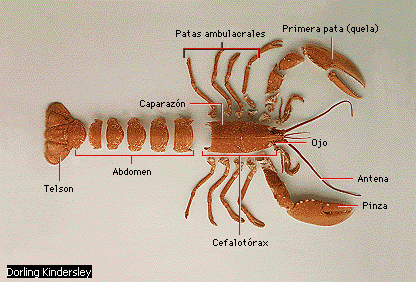
By taking advantage of this root concept, we try to define a first approximation of what the Exonovel would be:
“what supports a novel, which gives it inner strength and protects it, and without which it is not possible.”
The Web is a very interesting place to use as a contemporary example for the Exonovel. Let’s imagine a novel, on paper, which gave the necessary Internet adresseses to find other relevant components of it, parts of it that need other supports and other languages. This has already been done, I believe many of us already do so or have done it in our books.
It’s like an extension of the notion of the footnote, but referred to a Web site instead of this or that text or that encyclopedia. Besides having the advantage of being immediately accessible, it is interesting because we can make that kind of delocalized note that it is not just a simple note, but a component of the plot. Thus, the novel uses not only other media but what is important, other languages in this exonovel separated from the body of the novel.
This exonovel can be made of various materials, such as posts made by the author specifically for the novel, or may be blogs with an independent existence prior to the novel. In this case it would constitute an act of appropriation as this concept is understood in visual arts.
But you can also create websites that hold the novel through various materials, specifically YouTube videos filmed with unpublished material or consolidating what is already on the Net, or you can create profiles on Facebook that are characters in the novel, or linking to real Facebookprofiles that would automatically become part of the fiction and would be new characters.
The possibilities are many. Then there is the added bonus: the novel could evolve if the author allows these blogs, videos and facebooks to be open for the reader to leave comments, add nuance or even parallel plots in the novel. These would mean entering a practice that has been called fanfiction.
Is a type of exonovela increases as the complexity with materials that are added
The model that follows this type of exonovel is a shell and and a support that is outside the body of the book, dislocated, and conceptually keep san analogy with the exoskeleton of certain corals, which are their own excretions, and mostly separate from the body itself. Moreover, being a printed book, in which we limit ourselves to record links to those who have to go on the computer, it’s clear that the book is the absolute reference center of the novel, and only through information provided by the book we can access the exonovel, placed on the Web. The paper book is the “absolute center of reference” of the work.
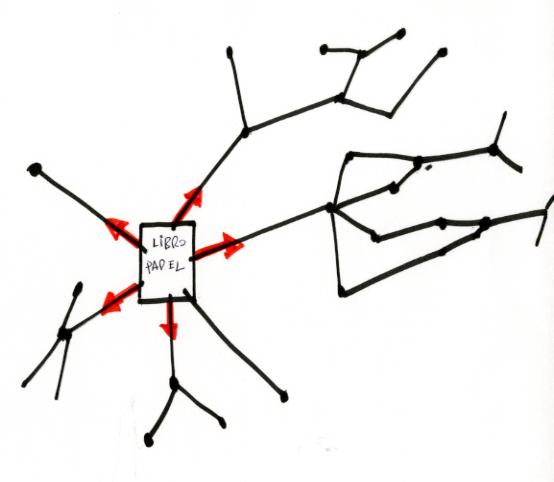
If the digital book is of an evolved status, such as a “tablet” (a sort of e-book that would allow direct links to the Internet on real time, and the inclusion of video and sound on the screen itself), the matrix text does not exist anymore, and would not be an absolute reference for the work. In this case we are in the typical configuration of Internet, which has no center or the center is at all times the place where that navigator is located. The flows go in both directions.
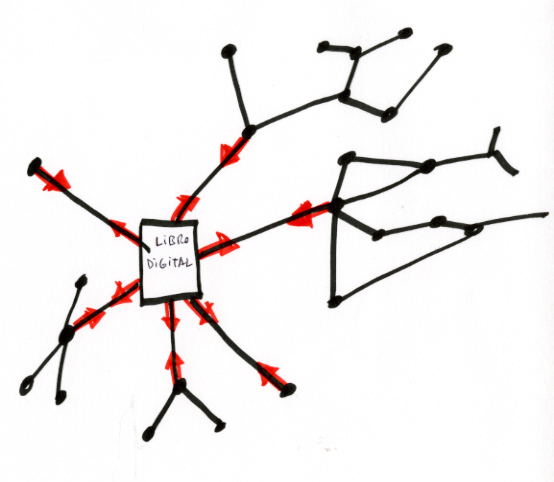
This model is the model I chose to expand my El hacedor (Borges) Remake (Alfaguara 2011, available for iPad tablet)
A simile:
Typically, the reader has a unique perspective on the book, just like a theater audience, that sits at a fixed point and watches the story develop from a rectangular stage. This is not only the case of the theater but also, originally, of the film. The French genius of the cinema, famous for introducing in the late 19th century the idea of film as entertainment and not just as a document and the inventor of the first special effects is remembered for his famous Trip to the Moon piece. He rolled and edited all his films the same way, from a frontal and single perspective just like the theater. The camera was equivalent to the spectators sitting in an armchair. It did not occur to them as it was out of their worldview and perspective to move the camera that was filming. The only movement came from the characters in the film. The camera was the same as a viewer. The camera was the viewer.
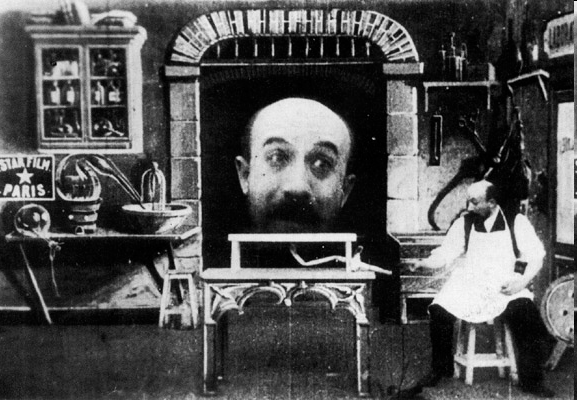
Frame of a Melies film. The viewer’s perspective is the one of a theatrical representation.
But in the early 20th century, someone thought the camera could film the actors moving, tourning behind them, making shots and reverse shots, like wanting to say : we will cover all points of view so that the viewer moves with the camera, which is a ubiquitous and mobile viewer. We will lift the audience of his/her theater seat to get him/her on stage and to see what was behind. This seems an acceptable imitation of what the expanded novel could be in the Network through its corresponding Exonovel, not settling for the idea that the reader is only one person in a chair, but moves by other systems and supports provided by the Internet. This is a very ambitious idea if you want to take it to the limit. We are now in its prehistory, its own Altamira cave stage. In my opinion, when it is sufficiently developed, it will replace what is now film and what was once architecture. I mean it as an artistic medium able to accommodate and transform other artistic practices. It is an idea that comes from the Baroque: the ambition to fill it all, to occupy all available space, to exhaust all possible techniques. The idea of having not only movement but accelerated motion. And that limit, of course, can also lead to failure.
From an uncoming essay, Agustín Fernández Mallo, 2011.




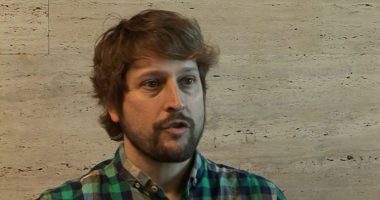
Marco K | 15 April 2011
Excelente reflexión. Muy creativa. Ayer vi tu conferencia en la universidad de Zaragoza, y también me pareció muy creativa, sorprendente, distinta en cuanto tu mirada de las cosas es inesperada, como lo que contsate de Deleuze, que decía que hacer filosofía es crear conceptos. Veo que es lo que tú haces, crear conceptos, entre filosóficos y poéticos, que abren caminos. No dan soluciones, sino que proponen caminos. Tengo ganas de leer ese ensayo. Espero que lo edites pronto. Gracias.
Óscar R. Cardeñosa | 15 April 2011
La última analogía respecto al movimiento de la cámara no me parece acertada, dado que la cámara modifica un único punto de vista, pero el concepto de novela interactiva o exonovela, o como se le quiera llamar, parece pretender dar un número indeterminado de puntos de vista, dependientes de la curiosidad e interés del lector.
Por otra parte, dar enlaces, música, videos y otros soportes a una novela tan sólo pone de manifiesto la interdisciplinaridad del arte en el mundo digital, y esto probablemente nos lleve a necesitar equipos de personas para trabajar en lugar de crear obras individuales, si se quieren desarrollar obras cuidadas y de calidad. La complejidad de este trabajo bien hecho, personalmente, me abruma.
A pesar de mis oposiciones, ¿qué sería del mundo si nadie persiguiera imposibles?
Carlos Vera Da Souza | 03 June 2011
Algunas cosas, solo como para aportar. La linealidad de la novela en papel llevada a exonovela deberá ser muy cuidada pues, supongo, que luego de leer parte de un texto texto el lector pasa a leer un texto-audio o texto-video entonces al terminar de leer ese texto-audio alojado en otra web o reservorio tiene que volver al texto-texto y si no hay un enlace o marca que lo traiga de vuelta se podría extraviar en la nube. La posibilidad de una no-linealidad también deberá tener su cuidado y el mejor ejemplo lo dio Julio Cortázar en Rayuela y por ello las marcas al final de cada capítulo para retomar la lectura en otro punto. Se me ocurre una posibilidad todavía más compleja que sería una exonovela 2.0, en una wiki por ejemplo con la construcción de la/s historia/s por sus lectores. Nada de esto será posible si, como dice Óscar, no trabajan juntas varias personas de diferentes perfiles.
Benjamín Escalonilla | 31 October 2013
Interesantísima terminología, y muy adecuada explicación. He publicado una exonovela, según esta definición: generación tch!, con Planeta. http://colectivotch.com/index.php
Seguir toca…
Gorki | 23 September 2018
Parece como si el DESTINO hubiera puesto este blog en mi camino.
Estoy preparando a un experimento que llamo “netgráfico”. O sea, un experimento literario escrito en lenguaje específico para la red digital, algo similar a lo que son. un lenguaje “cinematográfico” para el canal vídeo, “radiofónico” para el audio, o incluso “telegráfico” cuando el canal tenía que tener en cuenta el numero de palabras. Un lenguaje que aprovr3eche las posibilidades tecnicas que permiite el canal y eluda sus inconvenientes.
Explicado en esquema el concepto “netgrafico”, paso a hablar de mi proyecto en marcha aunque no en ejecución. Su título (rpocisional) es “El mundo de Hermógenenes” y se tradta de una biografía inventada de Hermógenes Álvarez desde que emprende un negocio de fabricacion de tornillos en Valdepeñas hasta que se muere, en un primer hilo con CEO de una multinacional que suministra el 90% de los medios de union de dos materiales, de clips, a rtornillos de relojes para la Industria relojera Suiza, y de tornillos de dos metros de largo y 40 cm de diametro, para las torres petroliferas, a los clavos de titanio que los cirujanos ponen en los huesos para reparar fracturas.
Todo lo que va a aparecer en esta obra netgráfica, es ficción con mezcla de hechos y objetos reales, como un determinado banco o de una determinad ciudad, y otros absolutamente ficticios. Las acciones que en ellos ocurren, no están basados en historias reales, por muy reales que parezcan, pero hay en casos, que son elaboraciones literarias que transmutan hechos reales ocurridos en otros lugares y circunstancias en productos ficticios, o ficticios (plagios) que pretenden ser mas atractivos que la gris realidad de la que parten.
Los hechos que se narran son obra unicamente de la imaginación de los autores y guionistas de esta producción netgráfica y cualquier coincidencia con la realidad, fuera de los nombres de entidades y lugares es pura coincidencia o coincidencia sin mayor importancia, como pueda ser la incorporación de un discurso de un diplomático. Lo unico importante es que vengan a cuento.
La estructura de este libro es ramificada, al modo de los antiguos libros del tipo, “Sigue tu propia aventura”, donde al final de cada capítulo se proponen al lector varias opciones de continuar la historia, de forma, que según su elección la historia tomará un rumbos diferentes.
Como consecuencia, nace un texto netgráfico vivo, pues se puede incluir en cualquier momento nuevos capítulos que continúen la historia en a partir de cualquier nodo. Esta característica, permite que el lector, participe en la confección de la obra, pues si una escena no le agrada, o él la hubiera hecho de otra forma, tiene la posibilidad de acceder al nodo anterior y crear una nueva opción, que de lugar a un nuevo hilo y mas ramificaciones, o simplemente una nueva alternativas en un punto que se bifurcan para volver a reunirse en el siguiente nodo.
Así, que si a ti, la historia no te atrae, no te quejes, simplemente continúala como el cuerpo te pida. Propón una continuación a tu gusto, sin mas limitación de respetar las personalidades de los personajes y los hechos anteriores y la incorporaremos al texto netgráfico, Texto que en principio, nunca daremos por acabado, esperando que de esta forma evolucione de una forma normal pero algo caótica.
Si estás interesado te pùedo ir mandando los avances que vaya haciendo y por supuesto puedes colaborar libremente en ella en el grado y cantidad que desees.
De momento y muy probablemente, para siempre, la obra es gratuita, pero si por cosas inesperadas de la vida, alguna vez produjera por el motivo que fuera dinero, tu como autor colectivo participaras de los ingresos, en función de las Kbites que supongan tu escrito sobre el peso total de obra.
Sin embargo, no te hagas ilusiones, lo mas probable, casi lo seguro, es que esta obra no produzca un duro, pues lo que buso, es generar el placer de leer y el placer de escribir de una forma moderna y colaborativa.
Por supuesto el proyecto se basa en enhebrar una pagina web con varias posibles continuaciones mediante links, pero también que en esas páginas web, se utilice todo tipo de material audiovisual, texto, imágenes, sonido, vídeos y quizá en el futuro añada la realidad virtual y que los lectores sean “`prosumidores” (consumidotres y productores de contenidos a la vez).
Como indico el experimenta actual es gratuito, pero la financiación que tengo prevista es de dos tipos, por una parte vírica y por otra parte incremental, Virica por que se basa, en que me “pirateén” la obra sin ningún coste, (algo basico en literatura en la red, e inclremental porque para poder participar como autor, y para poder recibir la actualización de la obra con las últimas incorporaciones de textos, habrá que pagar una pequeña cuota, por ejemplo 1 euro por actualización, con derecho por supuesto a divulgarla entre todos sus amigos.
Lo recaudado e descontado los gastos de hosting e ¿Impuestos?, se reparte proporcionalmente entre todos los participantes en función de los Kbites que aporten al proyecto, con lo que indirectamente estás potenciando el uso de audiovisuales, y un comité de autores, formado por los 20 con mas participaciones, decidirán si lo ofrecido por el escritor es digno o no de ser linkado al resto de la obra. Con lo que pongo un sistema de “badgets” que tanto éxito tuvo en otros proyectos digitales.
Leave a comment